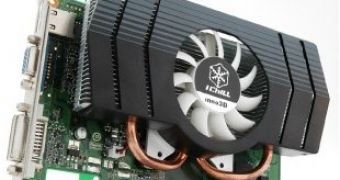Inno3D's i-Chill series of products is determined by the special cooling mechanisms employed in the temperature management. The product series has its own custom-designed cooler, namely the XStriker3. This cooler is especially designed with top-notch passive and active cooling mechanisms, which makes it especially efficient, allowing for certain optimizations to be made to the product it goes with, modifications that would be dangerous if not for a good-enough cooling solution.
Inno3D's i-Chill NVIDIA-powered GT 240 has faster core speeds, top-quality OS-COM capacitors, aluminum ramsinks that stabilize memory and gold-plated DVI, VGA and HDMI connectors that allow for a superior signal quality. Still, as the name suggests, it is the cooling module that gives this card its name and its temperature leverage needed for such a performance increase. The XStriker3 is exclusive to this line of i-Chill products and combines three features.
One is the Air Boost technology, which is based on Bernoulli's principle that states that all air particles follow the same patch at the same speed when in an environment with steady air pressure. As such, velocity modifications occur at the same time with pressure changes or with modifications to the airflow's gravitational potential energy.
A second aspect of the cooler is the Heatpipe technology. This element provides heat conductivity and vaporizes heat transfer through the use of copper heatpipes filled with liquid material, which extend from the graphics processing unit's center. The airflow is easily and efficiently dispersed by aluminum fins.
The third feature of the XStriker3 is its ability to merge silent cooling with large airflows. It combines active and passive cooling solutions in such a way so as to allow the air to circulate from the center and the sides, all the while systematically reducing noise.
Thanks to the i-Chill XStriker3 cooler, Inno3D's GT 240 can exceed its own performance capabilities without worrying about overheating-related card failure.

 14 DAY TRIAL //
14 DAY TRIAL //